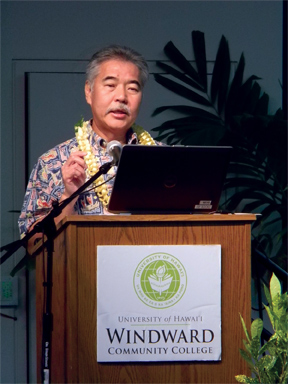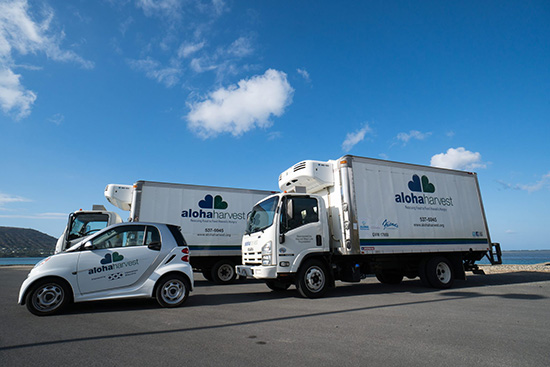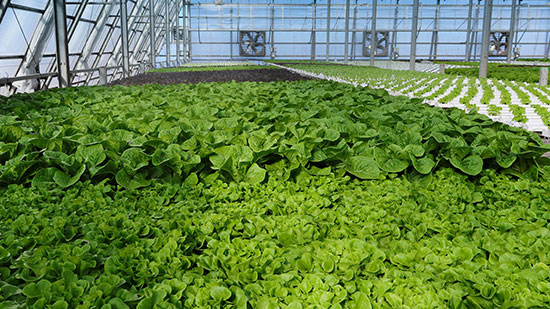
The Thirty Meter Telescope (TMT) project, affordable housing, homelessness and sustainability were among the issues raised by WCC students and the community at a town hall meeting Oct. 26 with Gov. David Ige and his cabinet.
The event was co-sponsored by the Associated Students of the University of Hawai‘i-Windward Community College (ASUH-WCC) and Ka ‘Ohana. Approximately 200 people crowded the room in ‘Ākoakoa to participate in what Ige says will be a series of events.
“We are going across the state so that we have an opportunity to engage community to talk about issues that are important to you,” said Ige. “I think the challenge will be that there’s many issues in our community.”
Prior to the public forum, Ige and his chief of staff Mike McCartney met with the ASUH-WCC and Ka ‘Ohana to discuss student concerns. Below are excerpts of that dialogue.
ASUH-WCC: Why are we still allowing a contract to be made with TMT?
Governor: As governor, I am required to enforce the law … I did visit Mauna Kea. I spoke with the protestors. I understand their feelings there, get what they feel about the mountain top and what is happening to it … My proposal was to create a cultural council that could do a better job of managing the rest of the summit … The project has committed significant sums beyond the lease to education, to cultural preservation and environment support, so I think those activities are ongoing and I think we can always do a better job to do that.
ASUH-WCC: Can we get a restructuring of the guidelines and policies for low-income public housing just to make them more affordable for our students to continue our education so we don’t have to worry about becoming homeless?
Governor: I think it’s part of the challenge of balance. You guys talk about affordable housing and yet you don’t want to see development in Ho‘opili or you don’t want to see further development of Hawai’i. But the reality is if there isn’t, then there’s not housing. That’s what drives the cost of housing …
We are having a summit with landlords to encourage them to rent to homeless and others who receive Section 8 vouchers and other rental assistance from the federal government … We are looking at more public/private partnerships on the public housing developments, and one of the things that we’re trying to move away from is rather than having a development 100 percent public housing is really to try to create better communities that include public housing … I do think that it’s really about trying to get the housing to work in all the various components as we try to build housing for the full spectrum of citizens that we have.
ASUH-WCC: I think we have an abundance of agriculture land that we don’t use. It will produce so much sense of community; it will get people off the streets and safe; and it will also produce sustainability, and we have food that we are actually making on our own land.
Governor: We definitely are working to improve sustainability. The Department of Agriculture is developing a plan to double the amount of food produced for consumption, so it’s really about changing the balance for how lands are used and providing more support for small farmers who tend to be those who produce food for consumption …
They definitely are aware it’s about refocusing programs to support small farmers. It’s about supporting them in food security and food processing and supporting co-ops, because typically the small farmers are working with other farmers of like mind to produce crops and looking for those programs that allow us to facilitate and help the small farmers deal with the government regulations … help them in processing, help them in getting their products to market in a way that allows them to be sustainable.
In the larger town hall meeting, moderator and executive director of the Pacific American Foundation Herb Lee led the Q&A segment, reading selected questions submitted by the public.
Q: How can our public schools improve their college preparatory programs, or in general be more competitive with mainland schools to increase students’ chances of enrollment in mainland colleges and/or be successful in college?
Governor: There’s a couple of things that I truly believe are game changers in our public schools, and it really starts with what I believe is the dual credit, that dual enrollment. It’s the early college … Our community colleges are working with our high schools so that when a student takes English that qualifies for college credit, they get both the high school credit and the college credit at the same time … I believe it’s the great answer for moving our public systems forward in that whole issue of college and career ready.
Q: Is it true that you will be relocating the homeless to a site in windward O’ahu?
Governor: I think part of the strategy really is finding shelter spaces in each and every community because homelessness has reached each and every community … We have been trying to find sites on the windward side so we can shelter the homeless on the windward side in areas that people choose to spend their time in. We don’t have any specific location at this point and time, but we are looking at state properties all across the state that would be suitable for establishing an emergency shelter. But I think, most importantly, we want to find the permanent housing situation for them … It’s really working with community partners, working with service providers, looking to establish a range of services in each and every community so that we can begin to build a network of service providers all across the state.
The meeting concluded with Ige’s response to the question, “Where do you see the state of Hawai’i at the end of your term as governor?” His response was to change the trajectory of Hawai’i, transform the culture of the government and focus on community engagement.
Ige said he wants to work with the community to find opportunities of “creating the Hawai’i that we would all want to have our children and our children’s children to be a part of.”
by Debbra Baetz, Ka ’Ohana Editor in Chief





